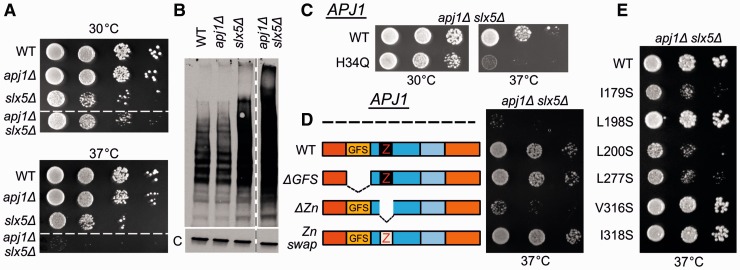Fig. 7.
apj1Δ and slx5Δ have a synthetic genetic interaction related to Sumo-mediated degradation. (A) Ten-fold serial dilutions of WT, apj1Δ, slx5Δ, and apj1Δ slx5Δ cells were spotted on rich media and incubated at indicated temperatures for 2 days. All strains in upper and lower panels were spotted on the same plate; dotted line indicates that irrelevant strains were spliced out of the figure. (B) Extracts of total protein isolated from WT, apj1Δ, slx5Δ, or apj1Δ slx5Δ cells were resolved by electrophoresis, electroblotted and probed with antibodies specific for Smt3, Saccharomyces cerevisiae sumo protein and, as a control, anti-Ssc1 antibodies (c). (C, D, E) Ten-fold serial dilutions of apj1Δ slx5Δ carrying the plasmids indicated below were spotted on media lacking tryptophan and incubated at indicated temperatures for 2 days. (C) pRS314-Apj1 (WT) or pRS314-Apj1H34Q (H34Q). (D) Empty vector (—), pRS314-Apj1 (WT), pRS314-Apj1Δ79-161 (ΔGFS), pRS314-Apj1Δ206-262 (ΔZn) or pRS314-Apj1Ydj1-143-206 (Zn swap). (E) pRS314-Apj1 (WT), pRS314-Apj1I179S (I179S), pRS314-Apj1L198S (L198S), pRS314-Apj1L200S (L200S), pRS314-Apj1L277S (L277S), pRS314-Apj1V316S (V316S), pRS314-Apj1I318S (I318S).

